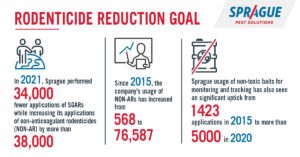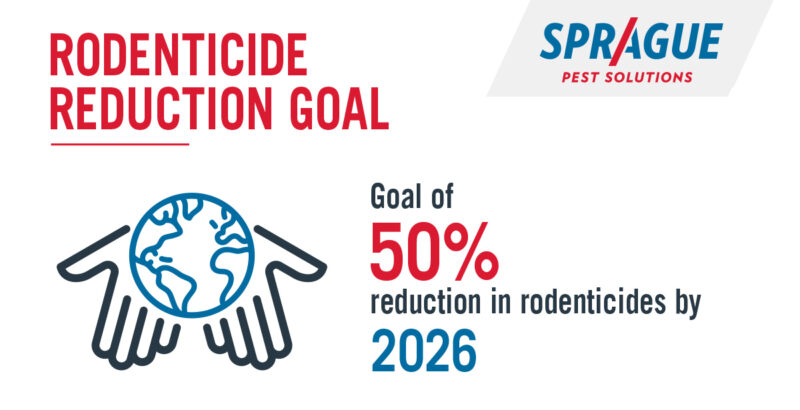Sprague's Goal is a 50% Reduction in Rodenticide Usage by 2026
While targeted applications of rodenticides remain part of a comprehensive integrated pest management (IPM) approach to rodent control, the types of rodenticide active ingredients and how they are used are changing.
Sprague Pest Solutions has been on the leading edge of rodenticide reduction for several years while continuing to deliver high quality, effective rodent control.

“Bait stations and traps are the most visible tool our clients and consumers see but they are really just two tools in a pest management professional’s rodent control toolbox,” said Lance Gray, A.C.E., regional manager for Sprague.
Gray explained that a complete rodent management program includes monitoring, trapping, exclusion, sanitation, habitat modification and education in addition to the targeted use of toxic and non-toxic baits.
“Sprague knew change was coming and we relied on science to guide us in making thoughtful changes to our approach,” said Gray. “We wanted to be different but at the same time still deliver on our promise to provide safe work and living environments and protect food and property.”
Sprague diverse geographic service footprint – 19 offices in 10 states – may sound like a challenge to manage but Gray said it’s just the opposite.
“We service a wide range of markets and know our approach in Los Angeles County may not work in Medford, Oregon and vice versa,” said Gray “This has driven our innovative spirit to adapt and share best practices when it comes to reducing rodenticide bait usage company-wide.”
Proof in Practice
How is Sprague achieving its goal of rodenticide reduction, yet still maintaining rodent-free facilities? Gray shared an example of how the old-school method of, ‘Just add more bait stations’ has been discarded and an innovative approach embraced.
A grocery store client was experiencing a chronic rat issue. The previous pest management service provider had used bait heavily, but Sprague knew there was a better way.
“We told the client that a bait only approach would continue to harvest lots of rats but would not solve the problem,” said Gray.
Instead, Sprague’s team talked with the store director to glean information on what exactly was going on inside the store. Trail cameras were installed underneath the refrigerated coolers where the rats were spotted to help identify the source of the rats entry.
In their discussions with the store director, it was learned that a remodeling project had been done and that the drain openings under the coolers led to a pipe. Where did that pipe go wondered Sprague?
As it turns the pipe was abandoned and its end point – which was a 100 yards away from the store – had not been sealed by the contractor during the remodel. The rats would come in the open drainpipe and enter the sales floor, identify their food source and escape with complete immunity.
With the pipe opening sealed up Sprague found a better way to solve the client’s problem that had nothing to do with rodent bait. It centered on dedicating the time to ask questions, investigate, use technology (i.e., cameras) and explore all options to identify the root cause of the problem. The result was no more rats inside the store and a significant reduction in bait usage.
Addition By Subtraction
Under its environmental stewardship pledge Sprague’s goal is to reduce second generation anticoagulant (SGARS) rodenticide usage by 50 percent by 2026.
In 2021, Sprague performed tens of thousands fewer applications of SGARs while increasing its applications of non-anticoagulant rodenticides (NON-AR). Since 2015, the company’s usage of NON-ARs has increased from a few hundred to tens of thousands of applications.
Sprague usage of non-toxic baits for monitoring and tracking has also seen a significant uptick. from a handful of applications in 2015 to more than 5,000 in 2020.
In its place the company is focusing on an integrated approach to rodent control using all the tools in its IPM toolbox.
“We are advocating for non-toxic baits to be used for monitoring when there has not been active feeding,” said Ashley Roden, technical manager for Sprague. “We don’t see the value in having rodenticide sitting there and posing a risk when you can use a non-toxic alternative.”
Discover The Sprague Difference
If you are looking for an environmentally responsible approach to rodent management for your commercial property, connect with the rodent management experts at 800.272.4988.

